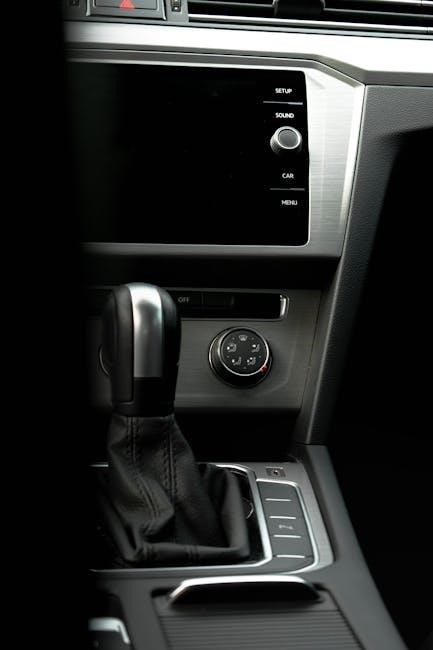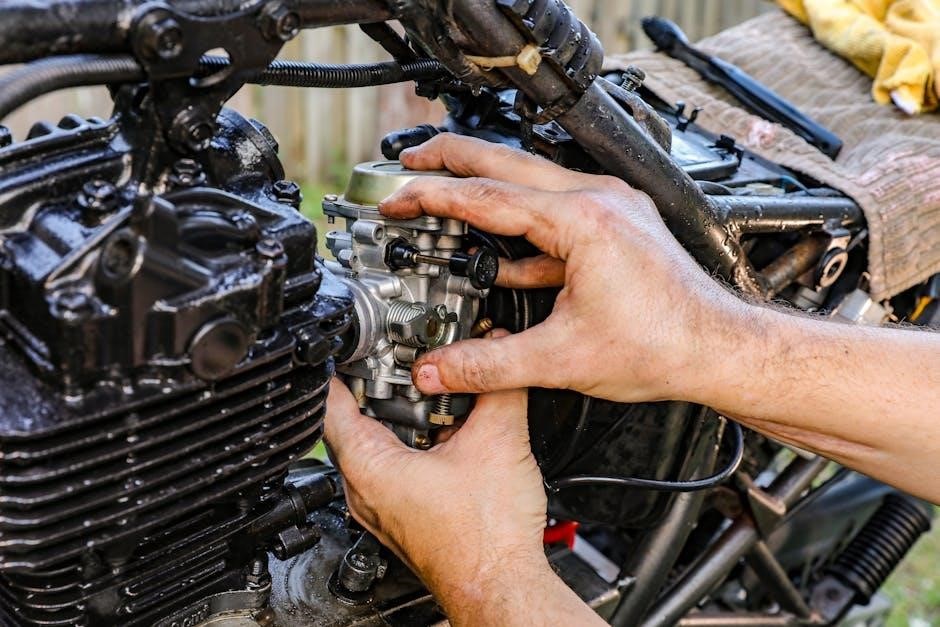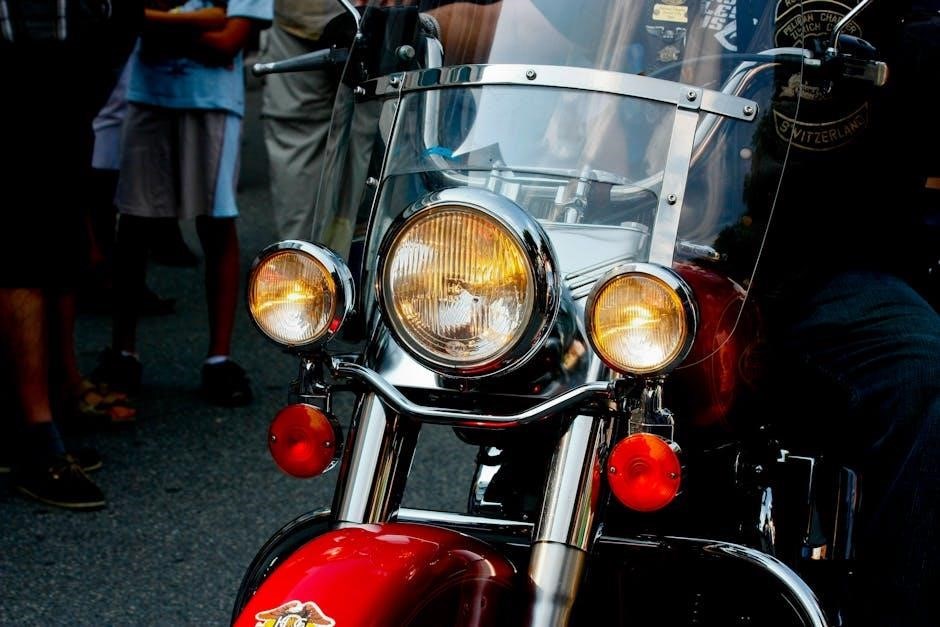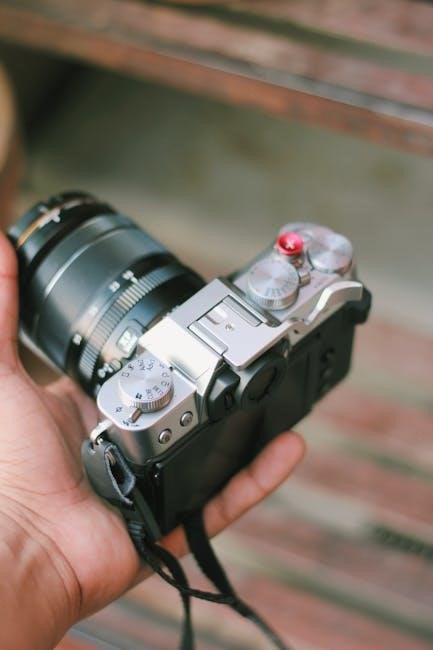Are Motorcycles Automatic or Manual?
Motorcycles can be either automatic or manual, depending on the transmission type. Manual motorcycles require shifting gears using a clutch and gearshift, while automatics shift gears automatically.
Motorcycles come in two primary transmission types: manual and automatic. Manual motorcycles require riders to shift gears using a clutch and gearshift, offering control over acceleration and speed. Automatic motorcycles, however, eliminate the need for manual shifting, providing ease of use, especially for beginners. The choice between the two often depends on the rider’s skill level, preferences, and the type of riding they intend to do.
Overview of Motorcycle Transmissions
Motorcycle transmissions determine how power is delivered from the engine to the wheels. Manual transmissions require riders to engage a clutch and shift gears using a gearshift, providing precise control. Automatic transmissions, including CVT and dual-clutch systems, automatically adjust gear ratios without manual input. Both types have distinct components and mechanisms, catering to different riding styles and preferences, whether for performance, convenience, or ease of use.
How Manual Motorcycles Work
Manual motorcycles operate via a clutch and gearshift, requiring riders to engage gears for acceleration and control, ensuring smooth power delivery and precise transmission management.
Components of a Manual Transmission
A manual motorcycle transmission consists of a gearshift, clutch, gearbox, and throttle. The shift lever selects gears, while the clutch disengages engine power. The gearbox houses gears and bearings, enabling smooth shifts. The throttle controls engine speed, working in sync with the clutch for seamless acceleration. These components ensure precise control over power delivery and gear transitions, essential for optimal performance and rider control.
Functionality of Clutch and Gearshift
The clutch, operated by a hand lever, disengages engine power from the transmission, allowing gear shifts without grinding. The gearshift, typically a foot lever, enables manual selection of gears. Riders pull the clutch, shift gears with the foot lever, and release the clutch gradually while applying the throttle for smooth acceleration. This system requires coordination and practice to master, providing precise control over speed and torque during rides.

Pros and Cons of Manual Motorcycles
Manual motorcycles offer better fuel efficiency, control, and affordability but require skill and effort. They suit experienced riders but can be tiring in heavy traffic.
Advantages of Manual Motorcycles
Manual motorcycles provide better fuel efficiency, increased control, and a more engaging riding experience. They typically cost less than automatics and offer more model variety. Riders can optimize gear shifts for performance or economy, making them ideal for experienced riders seeking precision and connection with their bike. Additionally, manual transmissions are often lighter and more reliable due to fewer complex components, enhancing overall performance and durability.
Disadvantages of Manual Motorcycles
Manual motorcycles require more skill and effort, as riders must operate the clutch and gearshift simultaneously. This can be challenging for beginners and may lead to frequent stalling. Additionally, manual bikes demand constant attention, especially in heavy traffic, which can be tiring. They also require more maintenance due to the complexity of their transmission systems, and the clutch may wear out faster with frequent use. This makes them less convenient for casual or city riders.

How Automatic Motorcycles Work
Automatic motorcycles use a torque converter or CVT to shift gears automatically, eliminating the need for manual clutch and gearshift operation, providing smoother, easier riding.
Components of an Automatic Transmission
An automatic motorcycle transmission typically includes a torque converter, gear sets, hydraulic controls, and a transmission control module. The torque converter replaces the clutch, engaging and disengaging automatically. Gear sets provide the necessary ratios for smooth power delivery. Hydraulic controls manage gear shifts based on speed and throttle input. The transmission control module ensures seamless operation by regulating the system. These components work together to provide an effortless riding experience without manual intervention.
Functionality of Automatic Transmissions
Automatic motorcycle transmissions operate by automatically shifting gears based on speed and throttle input. A torque converter connects the engine to the transmission, eliminating the need for a manual clutch. Sensors detect riding conditions, and hydraulic or electronic controls execute smooth gear changes. This system provides effortless acceleration and seamless power delivery, reducing rider fatigue and complexity. It’s ideal for urban commuting and riders who prefer a more relaxed experience without manual gear shifting.
Pros and Cons of Automatic Motorcycles
Automatic motorcycles are ideal for beginners, offering ease of use and reduced fatigue, but are often more expensive and heavier than manual counterparts.
Advantages of Automatic Motorcycles
Automatic motorcycles offer unparalleled ease of use, making them perfect for new riders or those who prefer a relaxed riding experience. They eliminate the need for manual shifting, reducing rider fatigue, especially in heavy traffic. The absence of a clutch and gearshift simplifies operation, allowing riders to focus on braking and acceleration. This makes automatic motorcycles ideal for urban commuting and hassle-free cruising, providing a more straightforward and enjoyable riding experience overall;
Disadvantages of Automatic Motorcycles
Automatic motorcycles have limited model options compared to manual bikes, which may not appeal to enthusiasts seeking more control. They are often heavier, affecting agility for smaller riders. Lower fuel efficiency is common due to the continuously variable transmission. Additionally, automatic motorcycles are generally more expensive to maintain and repair. The lack of manual gear control can also make them less engaging for experienced riders who enjoy the hands-on shifting experience of manual transmissions.

Comparison Between Manual and Automatic Motorcycles
Manual motorcycles offer precise control and better fuel efficiency, appealing to experienced riders. Automatics provide ease of use, perfect for beginners and urban commuting, though often heavier.
Key Differences
Manual motorcycles require manual shifting using a clutch and gearshift, offering more control but demanding skill. Automatics use mechanisms like CVT or dual-clutch, simplifying riding. Manuals are lighter and more fuel-efficient, appealing to experienced riders. Automatics are heavier but easier, suitable for beginners and urban commutes. Manuals need less maintenance, while automatics have complex parts. Riding experience varies: manuals provide engagement, while automatics offer relaxation. Cost and target audience differ, with manuals being cheaper initially and preferred by enthusiasts, whereas automatics may hold better resale value and attract casual riders.
Choosing the Right Type for Your Needs
Selecting between manual and automatic motorcycles depends on your riding style, experience, and preferences. Manuals are ideal for experienced riders seeking control and performance, while automatics suit beginners or those prioritizing convenience. Consider your commute—manuals excel in dynamic driving, while automatics shine in traffic. Fuel efficiency and maintenance needs should also guide your decision. Ultimately, test both to determine which aligns best with your lifestyle and riding goals.

Best Manual Motorcycles Available
Best manual motorcycles include Yamaha R6, Kawasaki Ninja ZX-6R, Ducati Panigale V2, Honda CBR600RR, and Suzuki GSX-R600. They offer powerful engines, precise handling, and aerodynamic designs, making them top choices for both novice and experienced riders.
Popular Models
Popular manual motorcycles include Yamaha YZF-R6, BMW R 1250 GS, Ducati Monster, Honda Africa Twin, and Kawasaki Ninja ZX-6R. These models are favored by enthusiasts for their precise control, responsive performance, and sleek designs. Yamaha YZF-R6 excels on the track, while BMW R 1250 GS offers adventure capabilities. Ducati Monster and Honda Africa Twin blend power with versatility, making them ideal for various riding styles. Kawasaki Ninja ZX-6R balances sportiness and practicality, appealing to both new and experienced riders.
Why These Models Stand Out
These manual motorcycles stand out for their exceptional performance, handling, and design. Yamaha YZF-R6 is renowned for its track-ready agility, while BMW R 1250 GS offers unmatched adventure capabilities. Ducati Monster combines raw power with a distinctive style, and Honda Africa Twin delivers versatility for both on-road and off-road rides. Kawasaki Ninja ZX-6R balances sport performance with everyday practicality, making these models favorites among riders seeking thrill and reliability.

Best Automatic Motorcycles Available
Popular automatic motorcycles like the Honda Gold Wing and Yamaha FJR1300 stand out for their smooth, effortless riding experience. These bikes feature advanced automatic transmissions, offering seamless gear shifts and reduced rider fatigue. The Honda Gold Wing, in particular, is celebrated for its luxurious comfort and innovative technology, making long-distance touring enjoyable. Yamaha’s FJR1300 combines sport-touring capabilities with an automatic transmission, providing both power and convenience for riders seeking a balanced experience.
Popular automatic motorcycles include the Honda Africa Twin DCT, BMW R 1250 GS, and Suzuki Burgman 400. The Africa Twin DCT offers adventure capabilities with smooth dual-clutch shifting, while the BMW R 1250 GS combines sport-touring prowess with an optional automatic transmission. The Suzuki Burgman 400 is a scooter-style bike with an automatic CVT, ideal for urban commuting. These models are renowned for their ease of use and refined performance, catering to diverse riding preferences.
These automatic motorcycles excel due to their advanced features and refined performance. The Honda Africa Twin DCT offers dual-clutch technology for seamless shifting, while the BMW R 1250 GS boasts adaptive cruise control and dynamic traction control. The Suzuki Burgman 400 combines a CVT with a spacious design, making it ideal for commuting. These bikes stand out for their innovative transmissions, ease of use, and superior comfort, appealing to both experienced riders and newcomers seeking convenience.

Maintenance and Care
Regular fluid changes, clutch inspections, and gearbox checks are crucial for manual motorcycles, while automatics require CVT belt replacements and drive system lubrication to ensure optimal performance.
Maintenance Requirements for Manual Motorcycles
Manual motorcycles require regular maintenance to ensure smooth operation. The clutch and gearbox need periodic inspections to prevent wear. Transmission fluid should be changed as recommended to maintain lubrication. Chain or belt drives must be lubricated and adjusted regularly. Proper care extends the life of components and ensures optimal performance. Regular checks help identify potential issues early, preventing costly repairs and ensuring rider safety.
Maintenance Requirements for Automatic Motorcycles
Automatic motorcycles require less frequent manual adjustments but still need regular upkeep. The transmission fluid should be checked and replaced as per the manufacturer’s schedule. Belt or chain drives must be inspected and lubricated to prevent wear. The CVT or torque converter systems benefit from periodic cleaning and inspection. Proper maintenance ensures smooth gear transitions and prolongs the lifespan of the automatic components, maintaining reliability and performance.

Learning to Ride a Motorcycle
Mastering motorcycle riding involves balancing, braking, and accelerating smoothly. Start with a bike that suits your height and skill level. Practice in a safe, open area to build confidence and coordination. Focus on controlling speed and shifting gears for manual bikes, while automatics simplify the process. Consistent practice helps develop muscle memory and improves overall riding proficiency.
Learning to Ride a Manual Motorcycle
Learning to ride a manual motorcycle requires coordination and practice. Start by familiarizing yourself with the clutch and gearshift. Practice in a safe, open area, focusing on smooth clutch engagement and gradual acceleration. Begin with slow-speed maneuvers to build control and balance. Training wheels can help initially, but remove them once confidence grows. Consistent practice and patience are key to mastering the manual transmission and enjoying the riding experience.
Learning to Ride an Automatic Motorcycle
Learning to ride an automatic motorcycle is often easier for beginners, as it eliminates the need to operate a clutch or manually shift gears. Start by practicing balance and throttle control in a safe, open space. Focus on smooth acceleration and braking to build confidence. The absence of a clutch allows riders to concentrate on steering and road awareness, making the learning process less complex and more intuitive for new motorcyclists.

Riding Experience and Techniques
Riding a motorcycle requires balance, coordination, and mastery of braking and acceleration. Manual bikes offer more control, while automatics simplify the experience, reducing clutch work.
Riding a Manual Motorcycle
Riding a manual motorcycle requires precise coordination between the clutch, gearshift, and throttle. The clutch disengages the engine from the transmission, allowing smooth gear shifts. Riders must feather the clutch during starts and stops to avoid stalling. Shifting gears at the right RPM enhances acceleration and control. Proper technique involves using engine braking and downshifting before turns for stability. Mastering these skills provides a more engaging and rewarding riding experience.
Riding an Automatic Motorcycle
Riding an automatic motorcycle simplifies the experience by eliminating manual gear shifts. The transmission automatically adjusts gears based on speed and acceleration, reducing rider input. This makes it ideal for beginners or those who prefer ease. Riders can focus solely on braking and throttle control. The absence of a clutch and gearshift reduces stalling risks and enhances comfort in heavy traffic. Automatic motorcycles deliver smooth power delivery and a more relaxed riding experience, perfect for urban commuting and casual cruising.
Fuel Efficiency and Performance
Manual motorcycles often offer better fuel efficiency due to direct control over gear shifts, optimizing engine performance. Automatics prioritize convenience but may slightly reduce mileage due to added weight and transmission losses.
Fuel Efficiency of Manual vs. Automatic Motorcycles
Manual motorcycles typically offer better fuel efficiency due to precise control over gear shifts, optimizing engine performance. Automatics, while convenient, often have slightly lower mileage due to added transmission weight and energy losses. However, the gap narrows with modern automatic designs. Riding style and terrain also influence efficiency, as manuals rely on rider skill for optimal performance, while automatics provide consistent operation regardless of rider expertise.
Performance Differences
Manual motorcycles generally offer superior acceleration and throttle response, as riders can control gear shifts precisely, maximizing engine power. Automatics, while smoother in operation, may lack the responsiveness of manuals, especially during rapid acceleration. Manuals are often preferred for racing and spirited riding, while automatics excel in urban commuting due to their ease of use and seamless power delivery, catering to different riding styles and preferences.
Reliability and Durability
Manual transmissions are generally more reliable and durable due to their simpler mechanical design, while automatics, with more complex components like hydraulic systems, are less reliable.
Reliability of Manual Motorcycles
Manual motorcycles are renowned for their reliability and durability due to their straightforward mechanical design. With fewer complex components, they are less prone to mechanical failures compared to automatics. The clutch, while requiring occasional replacement, is relatively simple and affordable to maintain. Manual transmissions also tend to be lighter, enhancing fuel efficiency and performance. Overall, manual motorcycles are preferred by many for their long-term dependability and ease of maintenance.
Reliability of Automatic Motorcycles
Automatic motorcycles are generally reliable, with fewer mechanical components compared to manual bikes. Their transmissions rely on hydraulic systems and sensors, reducing rider error. While they are less complex, automatics can be more prone to issues if improperly maintained. Regular fluid changes and system checks are essential. Despite this, automatic motorcycles are dependable for everyday use, offering convenience and ease of operation with minimal mechanical intervention required.

Future Trends in Motorcycle Transmissions
The motorcycle industry is moving toward advanced transmission systems, including dual-clutch technology and AI-driven automatics, enhancing performance, efficiency, and rider experience for future models.
Emerging Technologies
Next-generation motorcycle transmissions are embracing dual-clutch technology, seamless gear shifts, and AI-driven automatic systems. These innovations promise improved performance, reduced rider fatigue, and enhanced fuel efficiency. Continuous Variable Transmissions (CVT) and smart shift systems are also gaining traction, offering smooth power delivery and optimal engine performance across all RPM ranges. Additionally, hybrid and electric motorcycles are integrating advanced transmission systems, further pushing the boundaries of efficiency and rider experience.
Impact on the Motorcycle Industry
The shift towards automatic and dual-clutch technologies is reshaping the motorcycle industry, influencing consumer preferences and market dynamics. These innovations are driving demand for more efficient and user-friendly bikes, potentially broadening the appeal of motorcycling to a wider audience. As manufacturers adapt to these trends, the industry is likely to see increased competition and a focus on producing models that balance performance with accessibility, catering to both seasoned riders and newcomers alike.
Final Thoughts
Ultimately, the choice between automatic and manual motorcycles hinges on personal preference, skill level, and intended use. Manual bikes offer control and engagement, appealing to experienced riders, while automatics provide ease and convenience, ideal for beginners or urban commutes. Both types have evolved to meet rider needs, ensuring a smooth and enjoyable experience. Consider your lifestyle, riding habits, and long-term goals when deciding. Emerging technologies may soon blur these distinctions, but for now, each option remains a viable choice.
Recommendations for Riders
New riders should consider starting with automatic motorcycles for easier learning and reduced stalling risk. Experienced riders may prefer manual motorcycles for better control and performance. Regular maintenance is crucial for manual transmissions, especially the clutch system. Riders should weigh their lifestyle, riding frequency, and terrain when choosing. Test riding both types is highly recommended to determine the best fit. This ensures a more enjoyable and tailored riding experience.



